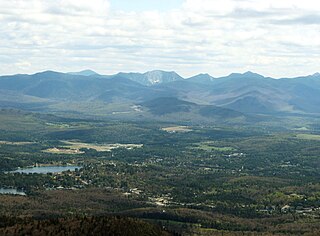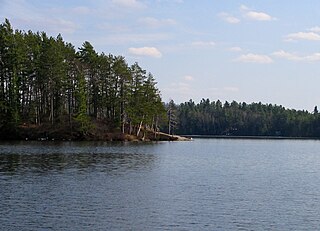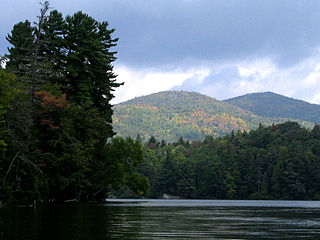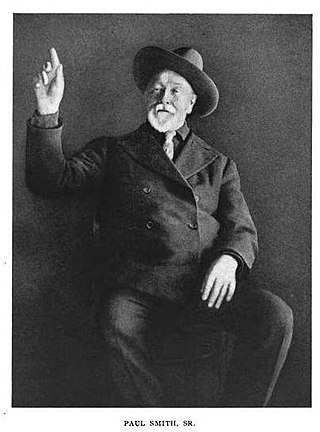
Franklin County is a county on the northern border of the U.S. state of New York. To the north across the Canada–United States border are the Canadian provinces of Quebec and Ontario, from east to west. As of the 2020 census, the county population was 47,555. Its county seat is Malone. The county is named in honor of United States Founding Father Benjamin Franklin. The county is part of the North Country region of the state.

Lake Placid is a village in the Adirondack Mountains in Essex County, New York, United States. In 2020, its population was 2,205.

Brighton is a town in Franklin County, New York, United States. The population was 1,435 at the 2010 census. It was named after Brighton, England, by early surveyors in the region.

Harrietstown is a town in Franklin County, New York, United States. The total population was 5,254 at the 2020 census, In 2010 3,879 of the town's residents lived in the village of Saranac Lake on the eastern side of the town.

Hopkinton is a town in St. Lawrence County, New York, United States. The population was 1,105 at the 2020 census and has a Population density of 5.9 square miles. The town is named for Roswell Hopkins, a pioneer settler and a government official.

Saranac Lake is a village in the state of New York, United States. As of the 2020 census, the population was 4,887, making it the largest community by population in the Adirondack Park. The village is named after Upper, Middle and Lower Saranac lakes, which are nearby.

The Adirondack Park is a park in northeastern New York protecting the Adirondack Mountains. The park was established in 1892 for "the free use of all the people for their health and pleasure", and for watershed protection. At 6.1 million acres, it is the largest park in the contiguous United States.

Paul Smith's College is a private college in Paul Smiths, New York. Paul Smith's College offers associate, bachelor's, and master's degrees. Its 14,000-acre campus is one of the largest college campuses in the world. As of 2023, approximately 600 students attend each year.

Paul Smiths is a hamlet and census-designated place (CDP) in the town of Brighton in Franklin County, New York, United States. It is located on Lower Saint Regis Lake in the Adirondacks, 12 miles (19 km) northwest of Saranac Lake, located at 44°26' North 74°15' West. The population of the CDP was 671 at the 2010 census.

The North Country is the northernmost region of the U.S. state of New York, bordered by Lake Champlain to the east, the Adirondack Mountains and the Upper Capital District to the south, the Mohawk Valley region to the southwest, the Canadian border to the north, and Lake Ontario and the Saint Lawrence Seaway to the west. A mostly rural area, the North Country includes seven counties. Fort Drum, a U.S. Army base, is also located in the North Country, as is the Adirondack Park. As of 2024, the population of the region was 420,311.
Lake Clear is a hamlet and a lake in Franklin County, New York, United States. The area is named for 940-acre (3.8 km2) Lake Clear, part of the original Seven Carries canoe route. It is located in the town of Harrietstown.

Upper St. Regis Lake is a 742-acre (3.00 km2) lake, part of the St. Regis River in the Adirondacks in northern New York State. Along with Lower St. Regis Lake and Spitfire Lake, it became famous in the late 19th century as a summer playground of America's power elite, drawn to the area by its scenery and Paul Smith's Hotel. It is the site of many old summer "cottages" and Great Camps, including Marjorie Merriweather Post's Topridge. Frederick W. Vanderbilt, Anson Phelps Stokes and Whitelaw Reid were among the summer residents. "The camps of many of these families began as tent colonies, with separate units for sleeping, dining, games, and so on, and evolved into permanent structures built with understated taste."

Lower St. Regis Lake is a part of the St. Regis River in the Adirondacks in northern New York State. At its northern edge is Paul Smith's College, former site of Paul Smith's Hotel. Along with Upper St. Regis Lake and Spitfire Lake, it became famous in the late 19th century as a summer playground of America's power elite, drawn to the area by its scenic beauty and by the rustic charms of Paul Smith's Hotel. It is the site of St. John's in the Wilderness, a small chapel originally built of logs, that was formerly attended by the families of shoreline property owners that arrived in canoes, rowboats and sailboats.

Spitfire Lake is a part of the St. Regis River in the Adirondacks in northern New York State and is 250-acre (1.0 km2) in area. Along with Upper and Lower St. Regis Lake, it became famous in the late 19th century as a summer playground of America's power elite, drawn to the area by its scenic beauty and by the rustic charms of Paul Smith's Hotel. It is the site of many grand old summer "cottages" and Great Camps; Frederick W. Vanderbilt, Anson Phelps Stokes and Whitelaw Reid were among the summer residents. "The camps of many of these families began as tent colonies, with separate units for sleeping, dining, games, and so on, and evolved into permanent structures built with understated taste."

The Seven Carries is an historic canoe route from Paul Smith's Hotel to the Saranac Inn through what is now known as the Saint Regis Canoe Area in southern Franklin County, New York in the Adirondack Park. The route was famous with sportsmen and tourists from major east-coast cities from the late 19th century through the 1930s; interest has revived in recent years. Despite the name, the route consists of only six carries, or portages.

Keese Mill—better known locally as Keese's Mills, but also spelled as Keeses Mill and Keeses Mills—is a hamlet west of Paul Smiths in the Town of Brighton, Franklin County, New York, United States, in the Adirondacks. It is named for a settlement established by employees of the two sawmills established by Keese and Tomlinson near their dam on the outlet of Lower St. Regis Lake Saint Regis River in mid-nineteenth century.

St. John's in the Wilderness Episcopal Church is an Episcopal church in Paul Smiths in the Adirondacks, New York State, United States. It was founded in 1876 by Dr. Edward Livingston Trudeau with the help of Paul Smith and many of the wealthy camp owners around Spitfire, Upper, and Lower Saint Regis Lakes. The original log building burned in 1928, and was replaced by the present structure, designed by William G. Distin, in 1930. The non-denominational cemetery surrounding the church contains the graves of Dr. Trudeau, Paul Smith, Charles Minot Dole, Clifford R. Pettis and several other notable residents of the area.

Apollos "Paul" Smith (1825–1912) was an American hunting and fishing guide from Vermont who founded the Saint Regis House in the Town of Brighton, New York, in the Adirondack Mountains. It was known universally as Paul Smith's Hotel, one of the first wilderness resorts in the Adirondacks. In its day, it was the most fashionable of the many great Adirondack hotels, patronized by American presidents, celebrities, and the power elite of the latter half of the 19th century. It was a large operation, with 255 rooms, stables, and many other amenities.

Loon Lake is a hamlet and a lake in the northeastern region of Adirondack Park in the U.S. state of New York. The community is located on the east side of Loon Lake and 18 miles (29 km) northeast of Saranac Lake and 27 miles (43 km) north of Lake Placid.
Stephen Warren Morehouse was a wilderness guide, cook, and hotel worker in the Adirondack region of northern New York... who served in the well-known 54th Massachusetts Infantry Regiment, one of the first Black regiments organized during the American Civil War. The Morehouse family also participated in a historic land-distribution project supported by the abolitionist John Brown and funded by the wealthy abolitionist and philanthropist Gerrit Smith. Smith granted 120,000 acres of his Adirondack property to 3000 free Black residents of New York State to help empower them through land ownership and also to help qualify them to vote.



















